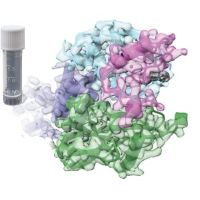Specification
| Organism | Homo sapiens (Human) |
| Expression Host | Mammalian cell |
| Tag Info | C-terminal Fc-tagged |
| Purity | Greater than 95% as determined by SDS-PAGE. |
| Uniprot ID | Q13261 |
| Uniprot Entry Name | |
| Gene Names | IL15RA |
| Alternative Names | CD215; IL15RA; CD215 antigen; IL-15 receptor subunit alpha; IL-15RA; IL-15R-alpha; interleukin 15 receptor; alpha; interleukin-15 receptor subunit alpha; MGC104179 |
| Expression Region | Partial (31-205aa) |
| Molecular Weight | 45.5 kDa |
| Endotoxin | Less than 1.0 EU/µg as determined by LAL method. |
| Sequence | ITCPPPMSVEHADIWVKSYSLYSRERYICNSGFKRKAGTSSLTECVLNKATNVAHWTTPSLKCIRDPALVHQRPAPPSTVTTAGVTPQPESLSPSGKEPAASSPSSNNTAATTAAIVPGSQLMPSKSPSTGTTEISSHESSHGTPSQTTAKNWELTASASHQPPGVYPQGHSDTT |
| Product Form | Lyophilized powder (Lyophilized from a 0.2 μm filtered 20 mM PB, 150 mM NaCl, pH 7.4) |
| Reconstitution | We recommend that this vial be briefly centrifuged prior to opening to bring the contents to the bottom. Please reconstitute protein in deionized sterile water to a concentration of 0.1-1.0 mg/mL.We recommend to add 5-50% of glycerol (final concentration) and aliquot for long-term storage at -20℃/-80℃. Our default final concentration of glycerol is 50%. Customers could use it as reference. |
Background
| Relevance | Interleukin 15 Receptor alpha (IL-15Rα) is a transmembrane glycoprotein that plays a pleiotropic role in immune development and function, including the positive maintenance of lymphocyte homeostasis. IL-15Rα chain can bind soluble IL-15 and “transpresent” cytokine to the cells, allowing them to respond to IL-15. Soluble IL-15Rα can function as a specific high-affinity IL-15 antagonist. The soluble IL-15/IL-15Rα complexes exhibit a strong agonistic activity which is mediated through membrane-bound IL-15 receptor β and γ heterodimers and enables signaling to cells. |
| Function | High-affinity receptor for interleukin-15. Can signal both in cis and trans where IL15R from one subset of cells presents IL15 to neighboring IL2RG-expressing cells. Expression of different isoforms may alter or interfere with signal transduction. Isoform 5, isoform 6, isoform 7 and isoform 8 do not bind IL15. Signal transduction involves SYK. |
| Involvement in disease | |
| Subcellular Location | Membrane, Single-pass type I membrane protein, Nucleus membrane, Single-pass type I membrane protein, Note=Mainly found associated with the nuclear membrane, SUBCELLULAR LOCATION: Isoform 5: Endoplasmic reticulum membrane, Single-pass type I membrane protein, Golgi apparatus membrane, Single-pass type I membrane protein, Cytoplasmic vesicle membrane, Single-pass type I membrane protein, Membrane, Single-pass type I membrane protein, Note=Isoform 5, isoform 6, isoform 7 and isoform 8 are associated with endoplasmic reticulum, Golgi and cytoplasmic vesicles, but not with the nuclear membrane, SUBCELLULAR LOCATION: Isoform 6: Endoplasmic reticulum membrane, Single-pass type I membrane protein, Golgi apparatus membrane, Single-pass type I membrane protein, Cytoplasmic vesicle membrane, Single-pass type I membrane protein, Membrane, Single-pass type I membrane protein, Note=Isoform 5, isoform 6, isoform 7 and isoform 8 are associated with endoplasmic reticulum, Golgi and cytoplasmic vesicles, but not with the nuclear membrane, SUBCELLULAR LOCATION: Isoform 7: Endoplasmic reticulum membrane, Single-pass type I membrane protein, Golgi apparatus membrane, Single-pass type I membrane protein, Cytoplasmic vesicle membrane, Single-pass type I membrane protein, Membrane, Single-pass type I membrane protein, Note=Isoform 5, isoform 6, isoform 7 and isoform 8 are associated with endoplasmic reticulum, Golgi and cytoplasmic vesicles, but not with the nuclear membrane, SUBCELLULAR LOCATION: Isoform 8: Endoplasmic reticulum membrane, Single-pass type I membrane protein, Golgi apparatus membrane, Single-pass type I membrane protein, Cytoplasmic vesicle membrane, Single-pass type I membrane protein, Membrane, Single-pass type I membrane protein |
| Protein Families | |
| Tissue Specificity | Isoform 1, isoform 3, isoform 4, isoform 5, isoform 6, isoform 7, isoform 8 and isoform 9 are widely expressed. Expressed in fetal brain with higher expression in the hippocampus and cerebellum than in cortex and thalamus. Higher levels of soluble sIL-15RA form in comparison with membrane-bound forms is present in all brain structures. |
| Pathway | Jak-STATsignalingpathway |
QC Data
| Note | Please contact us for QC Data |
| Product Image (Reference Only) |  |

